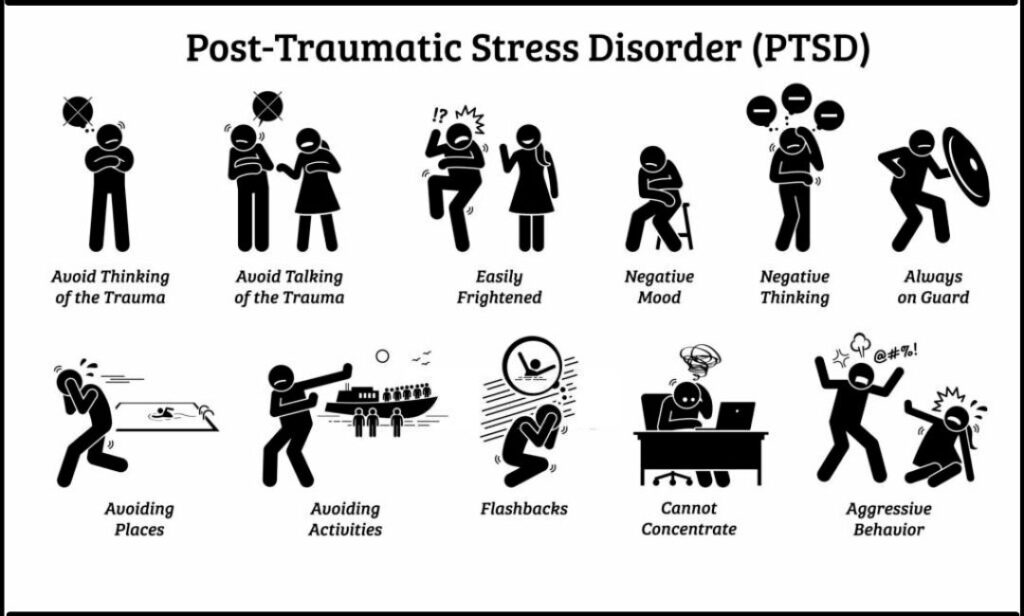Post-Traumatic Stress Disorder (PTSD) is a serious psychiatric condition that develops in some individuals after experiencing or witnessing traumatic events such as war, natural disasters, serious accidents, sexual assault, or other life-threatening incidents. It can profoundly impact an individual’s psychological, emotional, and physical well-being, often persisting for months or years without appropriate intervention.

Causes and Risk Factors of PTSD
Primary Causes of PTSD
- Exposure to Traumatic Events: Military combat, violent assaults, catastrophic accidents, natural disasters, or personal loss.
- Indirect Trauma: Witnessing trauma or hearing about violent events affecting loved ones.
- Childhood Adversity: Abuse, neglect, or unstable family environments can increase vulnerability.
Risk Factors
- History of mental illness or depression
- Lack of social support after trauma
- Substance abuse
- Genetic predisposition to anxiety or mood disorders
- Repeated exposure to trauma
Symptoms of PTSD: Recognizing the Warning Signs
PTSD symptoms are generally grouped into four main categories:
1. Intrusion
- Flashbacks
- Nightmares
- Distressing thoughts
- Involuntary reliving of the trauma
2. Avoidance
- Avoiding reminders of the trauma
- Emotional numbness
- Isolation from people and activities
3. Negative Alterations in Cognition and Mood
- Persistent negative emotions
- Distorted blame of self or others
- Memory issues related to the trauma
- Diminished interest in activities
4. Hyperarousal
- Irritability and anger
- Hypervigilance
- Difficulty sleeping or concentrating
- Exaggerated startle response
Diagnosis and Assessment of PTSD
PTSD is diagnosed by a qualified mental health professional through clinical interviews and standardized assessment tools. According to the DSM-5 (Diagnostic and Statistical Manual of Mental Disorders, Fifth Edition), a PTSD diagnosis requires the presence of symptoms in all four categories for over a month, resulting in significant distress or impairment in functioning.
Common Diagnostic Tools
- Clinician-Administered PTSD Scale (CAPS)
- PTSD Checklist for DSM-5 (PCL-5)
- Structured Clinical Interview for DSM-5 (SCID)
PTSD vs. Complex PTSD
Complex PTSD (C-PTSD) occurs after prolonged exposure to repeated trauma, often in childhood. While it shares core PTSD symptoms, C-PTSD also includes:
- Emotional dysregulation
- Persistent feelings of shame or guilt
- Difficulty forming healthy relationships
- Identity disturbances
Treatment Options for PTSD
Effective treatments are available, including psychotherapy and medication. Early intervention significantly improves prognosis.
Psychotherapeutic Approaches
- Cognitive Behavioral Therapy (CBT): Focuses on restructuring negative thought patterns.
- Prolonged Exposure Therapy: Encourages safe confrontation with trauma-related memories and situations.
- Eye Movement Desensitization and Reprocessing (EMDR): Uses bilateral stimulation to process trauma.
- Cognitive Processing Therapy (CPT): Challenges and modifies unhelpful trauma-related beliefs.
Pharmacological Treatments
- Selective Serotonin Reuptake Inhibitors (SSRIs): Sertraline and paroxetine are FDA-approved for PTSD.
- SNRIs: Such as venlafaxine, used for anxiety and depressive symptoms.
- Prazosin: Often prescribed for nightmares and sleep disturbances.
The Role of Support Systems in Recovery
Family, friends, and peer support play a crucial role in the recovery process. Creating a trauma-informed environment with empathy, validation, and stability can enhance treatment outcomes.
Community and Online Resources
- PTSD support groups (online and in-person)
- Veterans Affairs (VA) services for military-related PTSD
- Mental health NGOs providing counseling and helplines
Self-Help Strategies and Lifestyle Modifications
In addition to professional treatment, patients are encouraged to adopt self-care practices to manage symptoms and promote healing.
Helpful Techniques
- Mindfulness meditation
- Regular physical activity
- Structured daily routines
- Art, music, or journaling therapy
- Avoidance of alcohol and drugs
PTSD in Children and Adolescents
Children may express PTSD symptoms differently. Signs include:
- Regression to earlier behaviors
- Increased fear or clinginess
- Play that reenacts trauma
- Physical complaints like headaches or stomach aches
Early identification and child-specific therapy approaches such as Trauma-Focused CBT (TF-CBT) are vital for recovery.
Long-Term Outlook and Prognosis
With timely and evidence-based treatment, many individuals recover fully or learn to manage symptoms effectively. However, untreated PTSD can lead to:
- Chronic mental health conditions
- Substance dependence
- Difficulty maintaining employment or relationships
- Increased risk of suicide
Continued follow-up care, relapse prevention strategies, and strong support networks are key to sustained recovery.
Frequently Asked Questions:
What triggers PTSD symptoms?
Triggers vary but can include sounds, smells, environments, or anniversaries of the traumatic event that unconsciously remind the individual of the trauma.
Can PTSD develop years after the event?
Yes, PTSD can emerge months or even years after the traumatic experience, particularly if triggered by a new stressful event or life change.
Is PTSD a lifelong condition?
Not necessarily. Many individuals recover with the right combination of therapy, medication, and support, though some may experience chronic symptoms.
How is PTSD different from general anxiety?
While both involve fear and worry, PTSD is directly linked to a specific traumatic event and includes unique symptoms like flashbacks and avoidance behaviors.
Can PTSD be prevented?
While not always preventable, early intervention after a traumatic event and strong social support can reduce the likelihood of developing PTSD.
Post-Traumatic Stress Disorder is a complex yet treatable mental health condition that requires comprehensive care, empathy, and resilience. A combination of therapy, medication, and community support offers a pathway to healing. By fostering awareness and promoting evidence-based treatment, we can better support those affected and create a society that responds to trauma with compassion and strength.